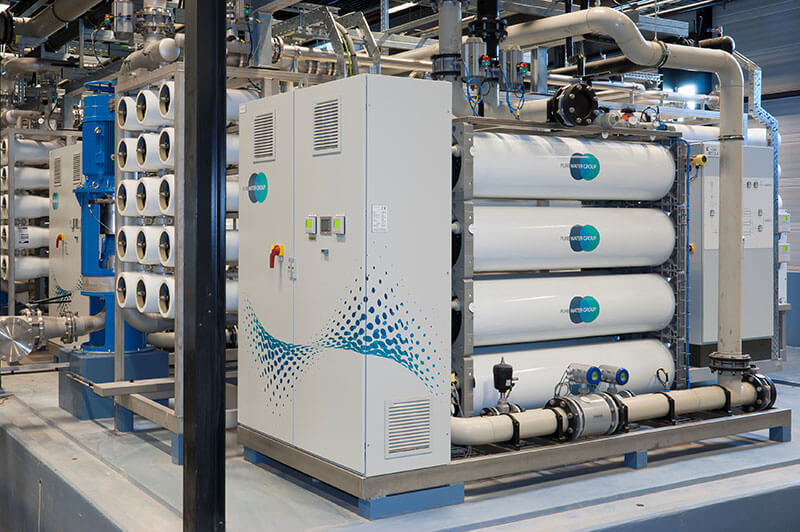Electro Deionization – EDI
Continuous, chemical-free production of
High Purity and Ultra Pure Water
Advanced Electro Deionization (EDI) technology is typically implemented downstream of Reverse Osmosis (RO) equipment and is used to produce High Purity and Ultra Pure Water. As the successor to more traditional Ion Exchange resin systems, environmentally friendly EDI systems now set the standard for demineralized water production. Consuming only electricity, EDI equipment can operate continuously, making pure product water of consistent quality, without chemical waste. The systems have a very limited footprint and frequent maintenance is not required.
Companies constantly focus on reducing operating costs, improving efficiency and eliminating the use of hazardous chemicals in the workplace. For High Purity and Ultra Pure Water production EDI strongly supports these goals and many thousands of systems have been installed over 30 years, operating successfully in many environments and applications.
Benefits of EDI:
- Environmental friendly – no regeneration chemicals needed
- EDI is a continuous process and produces a consistent water quality
- EDI systems are extremely compact and require minimal footprint
- Low operating cost (electricity only)
- Capital cost in line with traditional technologies
- Minimum facility requirements and operator attention
- High system recovery, concentrate water re-used upstream RO
- 1000’s of systems installed worldwide – up to a capacity of 1.500 m3/h
What is EDI? – Process and components
The Electro Deionization process uses ion exchange resins, ion-selective membranes and an applied DC electrical current to remove ions, such as salts, acids and bases. Weakly ionized materials, like dissolved silica, carbon dioxide, boron and some organics are also removed.
Most EDI modules are built with membranes that are permeable to either cations or anions, in an alternating sequence. The spaces between them act as liquid flow compartments, each with an inlet and an outlet. Dependent on the polarity of the ion exchange membrane and its orientation to a cathode or anode, an individual compartment either depletes the water of ions (product water) or accumulates ions (reject water).
To facilitate ion transfer in low ionic strength solutions, the dilute compartments and the concentrate compartments are filled with ion exchange resins. In an EDI module, a part of the feed flow, approximately 5% of the volume, continuously washes out the ions from the concentrate compartments. This concentrate outlet, also called the reject stream, is recirculated upstream of the RO system to be recovered, while the dilute compartments deliver purified product water.
Unlike traditional Ion Exchange resin systems, EDI needs no chemical regeneration. All EDI devices producing ultrapure water operate in electro-regeneration mode, in which the resins are continuously regenerated by H+ and OH- ions, released by the electrically-induced dissociation of water molecules.
Pure Water Group EDI solutions
For more than 25 years, Pure Water Group has worked with EDI – designing, constructing and supplying EDI systems to extract the very best from this technology. Our EDI systems can achieve up to 99,9 percent salt removal, reduce the levels of individual ionic species to parts-per-billion or even parts-per-trillion levels, and produce ultrapure water with a resistivity of 10 to 18 MegOhm.cm (0,1 to 0,055 microSiemens/cm conductivity).
But outstanding water quality alone is often not the only goal. In our experience, the importance of recycling water has grown steadily, particularly in industries such as power generation and semiconductor fabrication, where huge quantities of pure water are required. Since the EDI concentrate (or reject) stream contains the feed water contaminants at 5-20 times higher concentration, it can usually be recycled back to the RO pretreatment. The recycle option increases the total plant recovery and so minimizes overall water consumption.
Our reference projects
For more detailed information please have a look at our reference projects.
Most common uses for EDI
- Demineralized feed water for (supercritical) high pressure boilers including for Concentrated Solar Plants
- Pure water injection in gas turbines for NOx reduction
- Ultra Pure Water for Microelectronics / Semiconductor fabrication
- (Highly) Purified Water and Water For Injection for the pharmaceutical industry
- Demineralized water for the petrochemical industry
- Hospital applications including Hemodialysis
- University and laboratory DI water

How does it work?
Experience, expertise and attention
We believe there are only a few companies in the world to rival what we do.
Thanks to our extensive experience in water treatment solutions for a wide range of applications, we developed essential insights into the EDI, MD and EDR technologies and how they meet specific requirements ‘in the field’. This is reflected in the quality of technical/commercial support, training, service and documentation we provide.
So why not contact us? Our advice is free!
Contact us for further assistance
Interested what Pure Water Group can do for you? Just call us direct or fill out the contact form.
